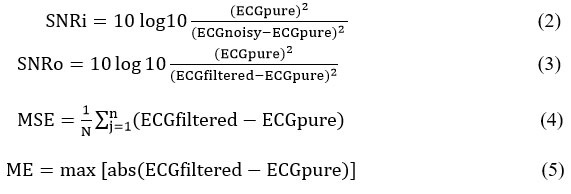Manuscript accepted on :22-10-2021
Published online on: 06-11-2021
Plagiarism Check: Yes
Reviewed by: Dr. Suneetha V

Second Review by: Dr. salman Ahmed Pharmacognosy

Final Approval by: Dr. Ayush Dogra
Nidhi Lakhera1, A R Verma1* , Bhumika Gupta2
, Bhumika Gupta2  and Surjeet Singh Patel3
and Surjeet Singh Patel3
1Department of Electronics and Communication Engineering, G. B. Pant Institute of Engineering and Technology, Pauri, Uttarakhand, India
2Department of Computer Science Engineering, G. B. Pant Institute of Engineering and Technology, Pauri, Uttarakhand, India
3Department of Electrical Engineering, G. B. Pant Institute of Engineering and Technology, Pauri, Uttarakhand, India
Corresponding Author E-mail: arverma06ei03@gmail.com
DOI : https://dx.doi.org/10.13005/bpj/2288
Abstract
An Electro cardiogram is commonly used in biomedical signal processing. It is used to monitor minor electrical changes in the human body. The electrical changes originate due to the function of heart. The anomalies of heart are found by ECG. In this work the Whale optimization algorithm is used to de-noising the ECG signal. The Whale optimization algorithm is used with Adaptive filter which filter the corrupted ECG signal. The performance of the ANC will be improved by calculating the optimum weight value. The WOA technique gives the best result on the different fidelity parameter compare to PSO, MPSO and ABC. The WOA technique gives the significant improvement in accuracy. It gives a good SNR, MSE, ME result compare to PSO, MPSO and ABC. The WOA gives 80% improvement in SNR 88% in MSE and 89% in ME as compared to PSO. So, by using WOA we get a desired ECG component. The WOA reduces the noise in ECG signal and improves the quality of signal.
Keywords
AF; ECG; MSE; ME; MPSO; PSO; SNR; WOA
Download this article as:| Copy the following to cite this article: Lakhera N, Verma A. R, Gupta B, Patel S. S. A Novel Approach of ECG Signal Enhancement Using Adaptive Filter Based on Whale Optimization Algorithm. Biomed Pharmacol J 2021;14(4). |
| Copy the following to cite this URL: Lakhera N, Verma A. R, Gupta B, Patel S. S. A Novel Approach of ECG Signal Enhancement Using Adaptive Filter Based on Whale Optimization Algorithm. Biomed Pharmacol J 2021;14(4). Available from: https://bit.ly/31G7fqB |
Introduction
The ECG is a very important screening tool. ECG provides the information about the human heart condition. It’s provides the information about electrical changes in the heart. It detects the anomalies of heart rate. ECG is pivotal detection of cardiac activities. It detects different types of disease related to heart. ECG is also finding the non-cardiac disease as emboli and electrolyte disorders. It records the heart rate. The different component is present in an ECG signal as the P wave, QRS wave, and T wave. These waves provide firm information about the ECG signal. To find the ECG signal the electrodes are placed on the human body and it finds the waveform of heart. The multiple view of heart activity is recorded by the ECG machine. The electrodes are also playing an important role to find out the multiple views in [1-4]. The major problem of ECG signal measurement is that ECG signal is degraded with noise. So to obtain a pure ECG signal right diagnosis of the signal is important. ECG is filtering and de-noising is important to clinical application. The important information of the waveform is affected by the noise. The noise is present due to different reason in the ECG signal.
ECG Artifacts
The noise present in ECG signal occurs by different cause. The noise is called artifacts in ECG signal. In the Power Line interference are occurs high frequency noise which is generated by respiration and body movement. The base Line wander consist low frequency noise which is generated by power lines at 50Hz to 60Hz frequency. The ECG signal is sensitive to SNR. The sensitivity is caused by the low frequency component of ECG signals. The low frequency band has some different internal and external noise. Internal noise commonly generated by the different function of the human body as- EMG. The external noise generated by the device used to measure the ECG signal as-Base line wandering. The signal filtering is very necessary to get the pure ECG signal. Because different noise is present in ECG signal so filtering of signal is a difficult task. Several methods are used to de-noising the ECG signal. The adaptive filter gives a good result over the different type of filter. The WOA technique is used to find good convergence or better fidelity parameter over PSO, MPSO and ABC in 4-7.
Adaptive filter
The adaptive filter coefficients are varying according to some condition. Its coefficient is changeable and adjustable according to requirement. The performance of the system has improved by these characteristics. Its characteristics adapt the change in parameters so it has a self-adjustable quality. The adaptive filter is widely used in biomedical signal enhancement. The adaptive filter is a very good method to remove noise or artifacts from ECG signal. It is used where the signal to noise occupies a proper distinct frequency band. The conventional filters are basically used to extract the signal but to remove the noise or artifacts the adaptive filter gives the better result. In many cases the coefficient of filter needs to be changeable. The adaptive filter is changing the signal characteristics according to need. Adaptive filter is mainly used by this reason:
When it compulsory to change the filter coefficient according to requirement.
When the signal and noise frequency overlap.
When the frequency occupied by the artifact is changing according to time.
The use of conventional filter is cause of distortion in the desired signal. Adaptive filter used like a noise canceller to produce a optimum result in corrupted signal. So by using the adaptive filter the accurate result of desired signal obtain in 7, 8. The feedback network updates the filter coefficient and it reduces the noise until the desired response is obtained. The d(n) is the corrupted ECG signal, s(n) is pure signal and q(n) is noise signal which consist the high frequency component as-power line interference and low frequency component as muscles noise. So the q1(n) is high recurrence noise and q2(n) is low recurrence noise. The q1(n) and q2(n) is are not correlated with s(n). The ANC filter used to generate the output signal y(n). The error signal e(n) is obtained by subtraction of d(n) and y1(n). Error signal feedback to the every cycle. This process is continued until the desired output obtain. The e1(n) is feedback until the high frequency component reduce in the first circuit. The final signal s’(n)+q’(n) consist low frequency component. Error signal e2 is generated by subtraction of s’(n)+q(n) and y2(n). The e2(n) is also feedback every instant until the e2(n) is reduce. The final stage gives s’(n) signal which is similar to s(n). The error signal is described by the following equation-
The eij is ith sample of n repetition. N is the total number of samples. To get optimum results in each iteration we used WOA technique. This algorithm gives the better rate of convergence, better global search, better fidelity parameter or easy to execute in 9, 10.
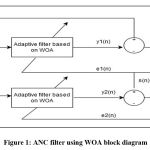 |
Figure 1: ANC filter using WOA block diagram |
Proposed method
ANC Filter Using Whale Optimization Algorithm
The Adaptive filter designed with whale optimization algorithm on noisy ECG signal gives a good performance. In the proposed work, the random noise is generated using Matlab 2013(a) which has a length of 18000. The fidelity parameters such as output Signal-to-Noise Ratio (SNR), Mean Square Error (MSE) and maximum error (ME) are varying according to, input Signal to noise ratio in [9,10]The different fidelity parameters are calculated using following mathematical terms:
The whale optimization algorithm is a meta-heuristic algorithm. It has two basic elements namely, exploration and exploitation. The exploitation is used for local search, which finds the information about the best search agent. The exploration is used to search the global optimum value. WOA technique uses killing nature of humpback whales. Which is analyzed and the process is completed by following two important methods:
The preys are chased by the random or best search agent.
Then the bubble net attacking method is used.
 |
Figure 2: Bubble Net Attacking Method. |
The humpback whale swims around the target, forming a thin shaped circle. It makes a winding path and creates distinct bubbles along the circle formed. The humpback whale uses two methods when they search for the prey. In mathematical terms for these 50% to choose among these two method to refresh the position of whales as follow-
It also forms a path which is similar to the shape 9. They have a very different hunting method which is often called as the bubble net feeding method in 11 WOA consist of two major phases described as follow
Encircling the prey
In encircling, the whale finds out the position of the prey and encircles them. In this method, we assume that the best solution is the target prey. The other search candidate continues to refresh the position. The mechanism is described by the following equation-
Where the current iteration is represented by t, the coefficient Vectors represented by A and C, the position vector of best solution is represented by X*, and the position vector of a solution is represented by X,| | is the absolute value.The vectors A and C are determined by the following equation:
Where components are linearly reduced to a from 2 to 0 in each cycle and the random vector r is in the range of [0, 1].
Bubble Net Hunting Method
The bubble net hunting method has two approaches to design a mathematical model.
Shrinking Encircling Prey
The value of A is a randomly chosen value in this method which lies between range [-a, a].Here, A is reduced by 2 to 0. The position is set to random values in the range of [-1, 1].The new position of a lies between the current and original position.
Spiral Position Updating
The spiral shaped mathematical model is used between position of the prey and the humpback whales. It follows the helix shaped path. The mathematical equation used for the position updating are-
D=|C.X*(t)-X(t)|
represent the distance between the prey(best solution) and ith whale, b is a constant, l is a random value in the range [-1,1] in 11-15
Search for prey
The search stage is also called exploration phase. The whales discover the prey by their random search. The whales change their position according to other whales. To oblige the search agent to relocate distant away from the reference whale, here we choose A with values greater than 1 or less than 1 in {16-25} The mathematical equation for the exploration is described as-
The random position vector chosen by current population is represented by Xrand in 11-25. The pseudo code and flow chart of WOA is shown below in fig 3 and fig.4
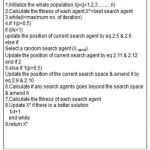 |
Figure 3: The ANC filter using WOA Pseudo code |
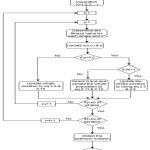 |
Figure 4: The Flow chart of WOA |
Result and Discussion
The ANC filter using WOA gives improved amplitude of P, Q, R, S pulse. The WOA technique gives more optimum result compare to PSO, MPSO and ABC technique as it detects ECG signal more accurately in 9
The WOA technique gives high quality improvement in output SNR, MSE and ME with respect to input SNR. It is by far better than the other PSO, MPSO and ABC technique. By using unmoral benchmark function F1 we obtain good SNR, MSE and ME for ECG signals. The best solution in objective space by using F1 is 2.7329e-28 and the best optimal value for F1 is 1.572e-65.
 |
Figure 5: ECG signal filtering using WOA. |
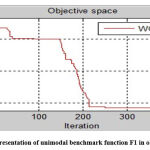 |
Figure 6: Representation of unimodal benchmark function F1 in objective space. |
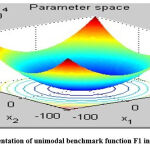 |
Figure 7: Representation of unimodal benchmark function F1 in parameter space. |
The comparative analysis of output SNR with respect to input SNR on different ECG signals is shown in the table1.
Table 1: Comparative result of SNR by using different technique on ECG signal
| Input SNR(db) | O/p SNR(db)
LMS [9] |
O/p SNR(db)
DWT [9] |
O/p SNR
(db) PSO [9] |
O/p SNR(db) MPSO [9] | O/p SNR(db) ABC SF [9] | O/p SNR
(db) WOA |
| -5.0 | 0.869 | 1.068 | 2.567 | 4.689 | 5.870 | 9.560 |
| 0.5 | 12.623 | 20.348 | 22.456 | 339.812 | 42.246 | 49.238 |
| 3.0 | 23.310 | 31.974 | 33.264 | 45.810 | 53.334 | 58.472 |
| 6.0 | 28.401 | 34.271 | 39.434 | 48.681 | 59.782 | 67.326 |
| 10 | 34.523 | 40.438 | 47.454 | 57.584 | 74.289 | 79.424 |
The comparative analysis of MSE with respect to input SNR are given in the table 2
Table 2: Comparative result of MSE by using different techniques on ECG signal
| Input SNR (db) | MSE(×)
LMS [9] |
MSE(×)
DWT [9] |
MSE(×)
PSO [9] |
MSE(×)
MPSO [9] |
MSE(×)
ABC [9] |
MSE(×)
WOA |
| -5.0 | 5.854 | 0.685 | 0.087 | 0.0568 | 0.0421 | 0.0261 |
| 0.5 | 2.989 | 0.197 | 0.120 | 0.0362 | 0.0342 | 0.0142 |
| 3.0 | 1.878 | 0.106 | 0.062 | 0.0225 | 0.0046 | 0.0031 |
| 6.0 | 1.154 | 0.096 | 0.036 | 0.0132 | 0.0010 | 0.0008 |
| 10 | 1.386 | 0.087 | 0.008 | 0.0002 | 0.0001 | 0.0001 |
The comparative analysis of ME with respect to input SNR are given in the table 3
Table 3: Comparative result of ME by using different technique on ECG signal
| Input SNR
(db) |
ME(×)
LMS [9] |
ME(×)
DWT [9] |
ME(×)
PSO [9] |
ME(×)
MPSO [9] |
ME(×)
ABC [9] |
ME(×)
WOA [9] |
| -5.0 | 28.5400 | 18.560 | 0.1032 | 0.0682 | 0.0208 | 0.0115 |
| 0.5 | 29.8900 | 19.780 | 0.0168 | 0.0045 | 0.0038 | 0.0025 |
| 3.0 | 18.7800 | 17.680 | 0.0084 | 0.0021 | 0.0009 | 0.0007 |
| 6.0 | 11.5450 | 0.9690 | 0.0059 | 0.0014 | 0.0006 | 0.0003 |
| 10 | 13.8600 | 0.3720 | 0.0022 | 0.0004 | 0.0002 |
0.0001 |
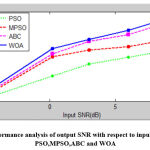 |
Figure 8: Performance analysis of output SNR with respect to input SNR by using PSO,MPSO,ABC and WOA |
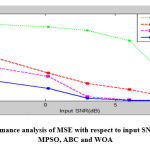 |
Figure 9: Performance analysis of MSE with respect to input SNR by using PSO, MPSO, ABC and WOA |
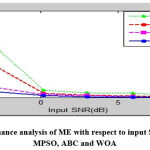 |
Figure 10: Performance analysis of ME with respect to input SNR by using PSO, MPSO, ABC and WOA |
Conclusion
The efficient ANC filter using WOA is developed for de-noising of ECG signal. The WOA gives better result for different fidelity parameters such as SNR, MSE and ME compared to PSO, MPSO and ABC technique. The ANC filter using WOA gives optimum solution compare to PSO, MPSO and ABC technique. This makes it a very attractive approach to find out better results for SNR, MSE and ME in comparison to PSO, MPSO and ABC for future prospective. The WOA gives a good convergence rate compare to swarm optimization such as PSO, MPSO and ABC so it is used for further comparison with the other technique.
Acknowledgement
Thanks to Dr. A. R Varma and Dr. Bhumika Gupta for helping in this paper.
Conflict of Interest
There are no conflict of interest
Funding Sources
There are no funding of sources.
References
- Ahirwal, M.K., Kumar, A. and Singh, G.K., 2012. Analysis and testing of PSO variants through application in EEG/ERP adaptive filtering approach. Biomedical Engineering Letters, 2(3), pp.186-197.
CrossRef - Ahirwal, M.K., Kumar, A. and Singh, G.K., 2013. EEG/ERP adaptive noise canceller design with controlled search space (CSS) approach in cuckoo and other optimization algorithms. IEEE/ACM Transactions on Computational Biology and Bioinformatics, 10(6), pp.1491-1504.
CrossRef - Shivika Goyal, Shefali Goswamy, Akanksha Negi, Aayushi Tomar, A. R. Verma, Y. Singh, “Design of ANC Filter Using Modified Cuckoo Search Technique for ECG Signal Enhancement”, ELSEVIER Journal-Perspectives in Science, doi: 10.1016 /j.pisc. 2016. 03. 002, ISSN : 209-0213.
- R. Verma, Y Singh “Adaptive Artifcat Cancellation Based on Bacteria Foraging Optimization for ECG Enhancement” Augmented Human Research (Springer) (2019), Vol. 3(3), 2019, pp.1-8, https://doi.org/10.1007/s41133-019-0014-5.
CrossRef - Joshi, V., Verma, A.R. and Singh, Y., 2015. De-noising of ECG signal using Adaptive Filter based on MPSO. Procedia Computer Science, 57, pp.395-402.
CrossRef - Kaur, H., 2016. Rajni,“ECG signal denoising with Savitzky–Golay filter and discrete wavelet transform (DWT),”. J. Eng. Trends Technol, 36(5), pp.266-269.
CrossRef - Feng-ru, W.H.J., 2008. An algorithm study of electrocardiogram signal de-noising by using wavelet thresholding mtheod [J]. Microcomputer Information, 21.
- Gupta B., Verma A. R, Kumar M. “A Novel Approach of QMF Bank Using Modified PSO Technique for Biomedical Image Applications”. Biomed Pharmacol J 2020;13(1).
CrossRef - Verma, A.R., Singh, Y. and Joshi, V., 2016. Adaptive filtering using PSO, MPSO and ABC algorithms for ECG signal. International Journal of Biomedical Engineering and Technology, 21(4), pp.379-392.
CrossRef - Verma, A.R. and Singh, Y. (2017) ‘Optimisation of two-channel QMF bank using modified cuckoo search technique for biomedical image applications’, J. Biomedical Engineering and Technology, Vol. 24, No. 1, pp.90–102.
CrossRef - Verma A. R. and Gupta B. “A Novel Approach Adaptive Filtering Method for EMG Signal using Gary Wolf Optimization Algorithm”, SN Applied Sciences (SNAS), (Springer) (2019), doi: 10.1007/s42452-019-1823-3.
CrossRef - Mirjalili, S., Mirjalili, S.M. and Lewis, A., 2014. Grey wolf optimizer. Advances in engineering software, 69, pp.46-61.
CrossRef - Verma A. R. and Gupta B. “A novel approach for classification of ECG beats based on Gray wolf optimization multiclass support vector machines classifier” Augmented Human Research (Springer) (2019), (https://doi.org/10.1007/s41133-019-0027-0).
CrossRef - Bozorgi, S.M. and Yazdani, S., 2019. IWOA: An improved whale optimization algorithm for optimization problems. Journal of Computational Design and Engineering, 6(3), pp.243-259.
CrossRef - Mohammed, H.M., Umar, S.U. and Rashid, T.A., 2019. A systematic and meta-analysis survey of whale optimization algorithm. Computational intelligence and neuroscience, 2019Brownlee, J., 2012. Clever Algorithms: Nature-Inspired Programming Recipes, lulu. com.
CrossRef - Verma A. R. and Gupta B., “Design BR-ABC Algorithm Based Fuzzy Logic of Glucose Detection” Augmented Human Research (Springer) (2019), https://doi.org/10.1007/s41133-019-0026-1).
- Verma A. R., Singh Y and Gupta B. “Adaptive Filtering Method for EMG Signal using Bounded Range Artificial Bee Colony Algorithm” Biomedical Engineering letter, springer, https://doi.org/10.1007/s13534-017-0056-x.
CrossRef - Verma A. R., Singh Y “Design of Multi-Channel Cosine-Modulated Filter Bank Using Bacterial Foraging Optimization Algorithm” IETE Journal of Education 59, No. 1, pp.39–50, 2018, https://doi.org/10.1080/09747338.2018.1483744.
CrossRef - Goldbogen, J.A., Friedlaender, A.S., Calambokidis, J., Mckenna, M.F., Simon, M. and Nowacek, D.P., 2013. Integrative approaches to the study of baleen whale diving behavior, feeding performance, and foraging ecology. BioScience, 63(2), pp.90-100.
CrossRef - Verma A. R. and Gupta B. “A Comparative Study of ECG Signal Heart Rate Variability Classification Based on Different Machine Learning Algorithms”, Augmented Human Research (Springer) doi:10.1007/s41133-020-00036-w.
CrossRef - Gupta B. and Verma A. R. “Design of 2D adaptive noise filter using MPSO algorithm for filtering biomedical image” Augmented Human Research (Springer) (2019), https://doi.org/10.1007/s41133-019-0017-2.
CrossRef - Ladumor, D.P., Trivedi, I.N., Jangir, P. and Kumar, A., 2016, December. A whale optimization algorithm approach for unit commitment problem solution. In National Conference on Advancements in Electrical and Power Electronics Engineering (AEPEE-2016), Morbi, Indea, Dec (pp. 4-17).
- Lin, L. and Gen, M., 2009. Auto-tuning strategy for evolutionary algorithms: balancing between exploration and exploitation. Soft Computing, 13(2), pp.157-168.
CrossRef - Verma A. R. and Gupta B. “Neuromuscular Disorder Detection using EMG Signals Based on TQWT Features” Augmented Human Research (Springer), DOI: 10.1007/s41133-019-0020-7.
CrossRef - Pan, W.T., 2012. A new fruit fly optimization algorithm: taking the financial distress model as an example. Knowledge-Based Systems, 26, pp.69-74.
CrossRef
Abbreviations:
WOA: Whale Optimization Algorithm
AF: Atrial Fibrillation
ECG: Electrocardiogram
MSE: Mean Squared Error
ME: Maximum error
MPSO: Modified Particle Swarm Optimization
PSO: Stochastic optimization technique
SNR: Signal-to-Noise Ratio







